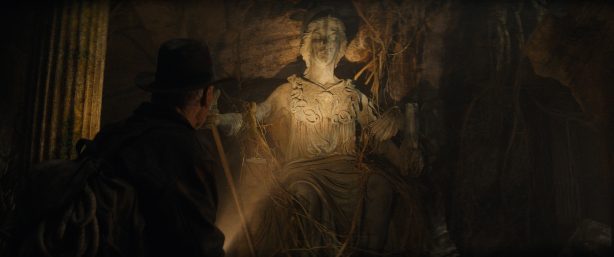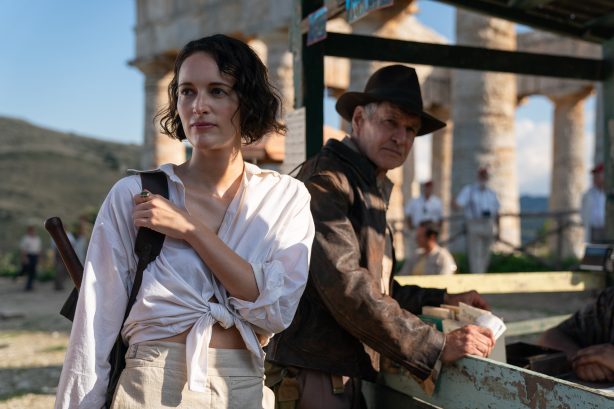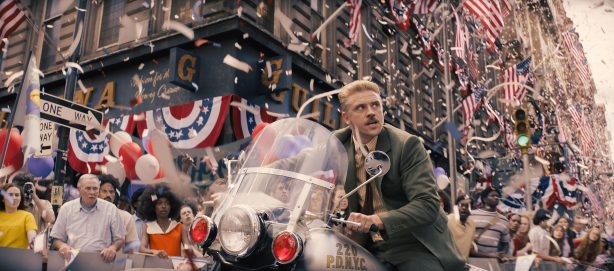Building upon its legacy of globetrotting exploits, Lucasfilm’s Indiana Jones and the Dial of Destiny—now playing in theaters—was filmed on location in Morocco, Sicily, and the U.K., providing multiple backdrops for the whip-smart archeologist’s unforgettable final adventure. Says director/co-writer James Mangold, “Part of what we expect in an Indiana Jones film is a tumbling menagerie of characters coming at us while they travel the world.”
With that in mind, Mangold worked with production designer Adam Stockhausen, director of photography Phedon Papamichael, special effects supervisor Alistair Williams, and visual effects supervisor Andrew Whitehurst to develop the film’s dynamic action sequences and awe-inspiring visuals—which fans have come to expect ever since Indiana Jones and the Raiders of the Lost Ark was released in 1981, setting the tone for decades of international escapades. So, to give Indiana Jones (Harrison Ford) a proper sendoff, the production team constructed large set-pieces, which included a 1944 train sequence in Germany, a horseback pursuit through a ticker tape parade in New York, a frenzied tuk tuk chase through the streets of Tangier, and a tense underwater dive in Greece, to name just a few.

“I think that is core to what makes these movies special; it’s different to be in a place than to pretend you’re in a place,” Stockhausen says of their considered approach. “Being in a place brings all the authenticity of the real thing, and it brings all the surprises of being able to twist and turn around corners that you wouldn’t have imagined to build into a set.”
The real-world locations and practical sets helped the cast get into character. “They each had their own personality,” says Phoebe Waller-Bridge, who joins the franchise as Helena Shaw. “Sicily was beautiful and serene, Morocco was full of bustle with a thousand things happening around you at the same time, and Glasgow has an energy I wish I could bottle.”
At the same time, Stockhausen strove to match the visual grandeur of the real-world locations with the massive and richly detailed sets he constructed at Pinewood Studios just outside of central London. The explosive opening sequence was a prime example of the way the film smartly married impressive locations—including England’s Bamburgh Castle and the North Yorkshire Moors Railway station—with Stockhausen’s inventive designs. The nighttime set piece sees the younger Indy attempting to rescue his friend Basil Shaw (Toby Jones) from Nazi captors aboard a moving train. “I wanted to give the audience what they want right up front,” Mangold says, “so we indulge in this Indiana Jones classic experience.”

Following the prologue, Indiana Jones and the Dial of Destiny jumps to 1969, when an estimated 4 million people lined the streets of New York City to see NASA astronauts Neil Armstrong, Buzz Aldrin, and Mike Collins and celebrate the success of the Apollo 11 mission to the moon. Staging the parade and the chase that follows required considerable planning in Glasgow, Scotland, which doubled for Manhattan. The production team spent three weeks dressing Glasgow’s main artery, St. Vincent Street, which was then closed to the public for seven days as filming took place. Says Stockhausen, “You can’t walk into a downtown metropolitan area and just take it over for three months. You have to do your work in as compressed a period of time as you can possibly manage and then get out and let people get back to their lives. So, there was an incredible intensity for everyone to rush in and do all this dressing, put up all these signs, put up all this bunting. It was go-go-go.”
Fortunately for Papamichael, the weather cooperated while they were filming outdoors. “Although it was all shot in Glasgow, it felt like we were really in New York in the late ’60s—the scale of it, the colors, the hippies, the pipers, the big band, the cheerleaders, and the cars, and police on horses. The contrast couldn’t be greater than the sequence that precedes it. You explode from the night and the Nazis into this whole new visual bouquet of colors and tone,” he explains. “It worked as a great visual device for a transition of time.”

As the chase progresses, Indiana finds himself, on horseback, riding underground through Manhattan’s subway tunnels, racing an oncoming train. For those scenes, Stockhuasen created a full-scale replica of a subway station on Pinewood’s 007 stage—the largest soundstage in the world—complete with paint and tile work that was aged for authenticity.
When the story’s action moves to Morocco, exteriors were shot in the city of Fez, while the lavish interiors of the Hotel L’Atlantique—where Helena auctions off her loot—were built at Pinewood. Meanwhile, Sicily stood in for Greece, where—with Renaldo (Antonio Banderas)—Indiana and Helena dive into vast caverns to follow the trail of Archimedes.
Ultimately, Ford says it was “critical” to film on location. “You want to go to many places around the world. You want to feel these places, you want to smell them, as it were,” the actor explains. “And so, we want as much as possible to have practical sets, practical locations where there’s a different culture, where there’s a different feeling to the place.”